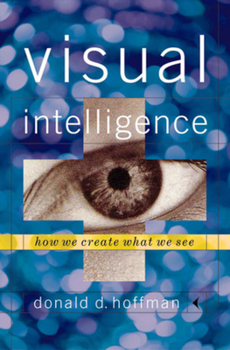Visual Intelligence: How We Create What We See
Select Format
Select Condition 
Book Overview
We have long known about IQ and are beginning to appreciate emotional intelligence; yet there is another fundamental dimension of intelligence that shapes our experience. Our visual intelligence engages roughly half the brain's cortex and goes largely unnoticed. Far from a passive recorder of a pre-existing world, the eye actively constructs every aspect of our visual experience. In an informal style, Donald Hoffman presents the scientific evidence for vision's constructive powers.
Format:Hardcover
Language:English
ISBN:0393046699
ISBN13:9780393046694
Release Date:October 1998
Publisher:W. W. Norton & Company
Length:320 Pages
Weight:1.59 lbs.
Dimensions:9.6" x 1.1" x 6.5"
Customer Reviews
5 ratings
informative and refreshing
Published by Thriftbooks.com User , 15 years ago
I used this book as part of an undergraduate course on visual intelligence for natural scientists, where it proved to be very useful as it helps to show how much of a construction is the mere fact of observing an object, diluting thus the opposition between "observing" and "imagining". Notwithstanding this last statement, this book should be an excellent read even for a less academic readership.
informative and entertaining
Published by Thriftbooks.com User , 15 years ago
This is a really interesting book. I have read it several times, and still occasionally pick it up to re-read a section. I teach drawing to architects and interior designers, and usually require them to read at least the beginning, so that they really begin to understand the task at hand when they draw. The mix of science, philosophy, and optical humor makes it an easy read.
Excellent Introduction and Reference Material
Published by Thriftbooks.com User , 22 years ago
Got this book out of our company library and found very easy to read, insightful and helpful in understanding the basics of human perception. Information on how we filter information is very helpful in designing a range of systems for humans to use. I've recommended this book to my peers at work and have bought a private copy for myself.
I loved reading this book
Published by Thriftbooks.com User , 23 years ago
This book is a lot of fun to read, not only because it's really interesting but because you learn through experience while you read. The book is about how our minds interpret the visual information that our eyes see, and it includes many visual examples -- optical illusions, basically, that make you pay attention to how your mind is working while you take in the experience.I read the book because of an interest in graphic design, and it brings design concepts together with psychology and biology in a really involving way. It was just a pleasure to read from the beginning to almost the end.Another reviewer points out that the last chapter is a bit of a letdown, and that's true. It's kind of an "everything's relative and you construct your own reality" message that's obviously very important to the author for academic reasons but much less so to the audience. Still, it takes nothing away from the rest of this fascinating book.
Visual process as active construction
Published by Thriftbooks.com User , 25 years ago
We construct our visual and perceptual experience of objects by touch, taste, smell, sound and sight -- or as cognitive scientist Donald Hoffman writes in VISUAL INTELLIGENCE, "... to experience is to construct, in each modality and without exception". Hoffman sets forth an extremely detailed and convincing explanation to support this assertion, and in the process takes us on a journey through the rules of visual intelligence. Many of us know that we construct each curve or surface we see, since the rods and cones inside our eyes use discrete pixel-like "dots" that can only approximate the images we perceive... but I didn't realize until I read this book how powerfully our visual interpretations affect our emotional responses.





